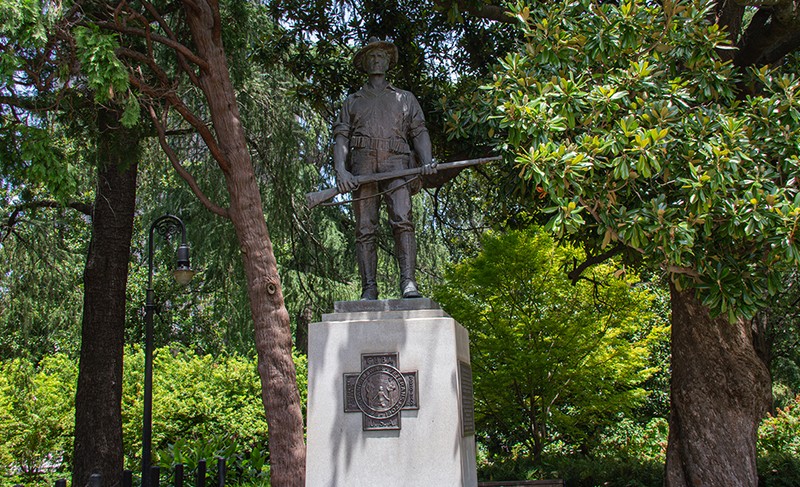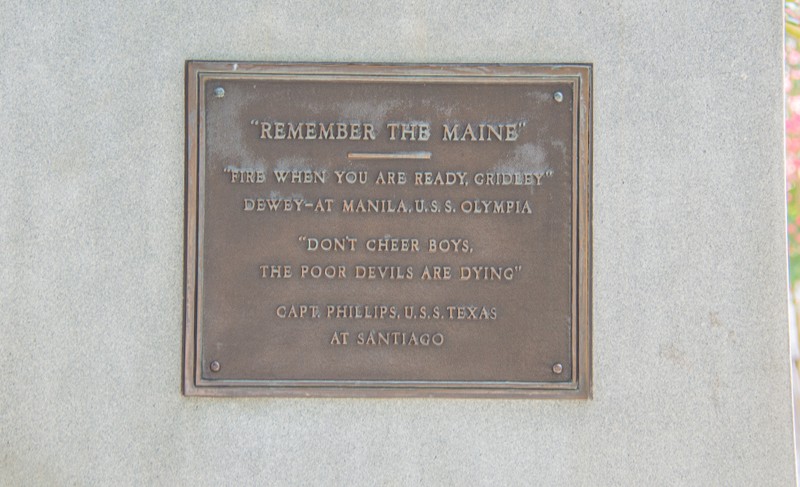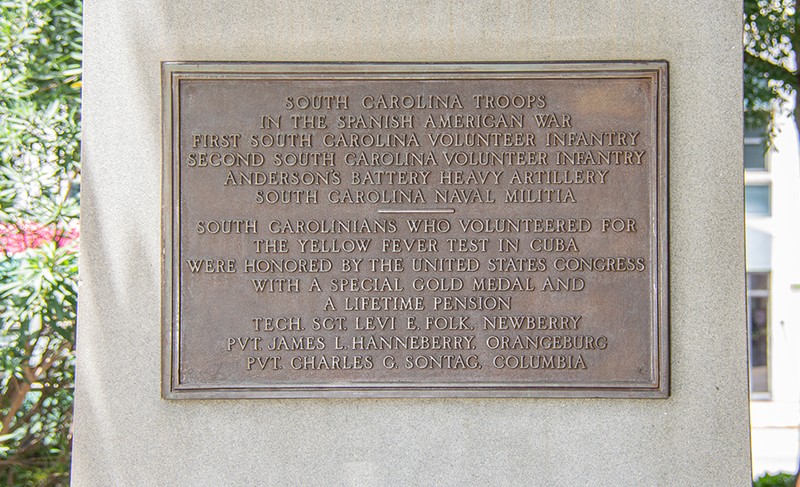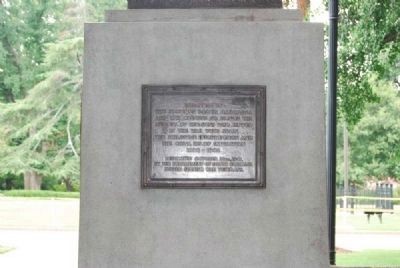Spanish-American War Veterans Monument
Introduction
Text-to-speech Audio
Images
Spanish-American War Veterans Monument, 2019. This image shows the West plaque, the Spanish War Veterans insignia.

North plaque, Spanish-American War Veterans Monument

South plaque, Spanish-American War Veterans Monument

East plaque, Spanish-American War Veterans Monument.

Backstory and Context
Text-to-speech Audio
The Spanish-American War Veterans Monument was erected in Columbia, South Carolina in 1941 and was meant to serve as a reminder of how the United States had once again been united for a victory during the war, after the Civil War had divided the nation. Because of the unity it formed, the Spanish-American War is only second to the Civil War as the most memorialized military conflict on State House grounds, despite South Carolina sending fewer than 1,000 soldiers into the war. The army in South Carolina was largely involved in raising volunteer regiments, as well as hosting military camps. In Columbia, Camp Fornance became the headquarters for the Third Brigade of the Second Division of the Second Army Corps. Soldiers from Camp Fornance served in both Cuba and the Philippines.
There were several other camps in Columbia during the Spanish-American War, such as Camp Ellerbe, Camp Dewey, also known as Geiger and Fuller, Camp Fitzhugh Lee, and Camp Prospect, among others. Those camps typically served primarily as mustering camps, meant to assemble and prepare troops for battle. Over 10 weeks, Spain and the United States fought in the Caribbean and Pacific in 1898, marking the first military action in which southerners and northerners in America had fought together since before the Civil War. The battle resulted in American victory, in which the United States acquired the territories of Puerto Rico, Guam, and the Philippine Islands.
In a 1932 meeting, South Carolina’s Spanish-American War veterans proposed to have the memorial statue built. During the toast, it was stated that the war had “united the United States, and wiped out the divisions left by the Confederate war,” (1). The group of the United Spanish War Veterans raised around half the funds for the statue, $1,500, which was matched by the State Legislature. Other funds were contributed by the City of Columbia. In total, the monument cost $4,200, and was installed on October 22, 1941.
The Spanish-American War Veterans Monument was designed by Theo Alice Ruggles Kitson, making it the only monument designed by a female artist on the State House grounds. Cast by the Gorham Manufacturing Company, the Department of South Carolina War Veterans erected a bronze cast of “The Hiker,” a statue found throughout the country on Spanish-American War monuments. It features a full-length figure of a uniformed Spanish-American War infantryman on a square pedestal with a three-tiered base, holding a rifle horizontally. The soldier has an open shirt with rolled sleeves, baggy pants, and high leather boots, meant to represent the informal uniform designed for combat in tropical locations. The plaques surrounding the base of the monument read:
[West Plaque]:
Spanish War Veterans Insignia
[South Plaque]:
South Carolina Troops
in the Spanish-American War
First South Carolina Volunteer Infantry
Second South Carolina Volunteer Infantry
Anderson's Battery Heavy Artillery
South Carolina Naval Militia
—————
South Carolinians who volunteered for
The Yellow Fever Test in Cuba
were honored by the United States Congress
with a special Gold Medal and
a Lifetime Pension
Tech. Sgt. Levi E. Folk, Newberry
Pvt. James L. Hannerberry, Orangeburg
Pvt. Charles G. Sontag, Columbia
[East Plaque]:
Erected by
the State of South Carolina
and her citizens to honor the
memory of her sons who served
in the War with Spain,
The Philippine Insurrection and
The China Relief Expedition
1898-1902
Dedicated October 22nd, 1941
by the Department of South Carolina
United Spanish War Veterans
[North Plaque]:
Remember the Maine
—————
"Fire when you are ready Griddey."
Dewey - at Manilla, U.S.S. Olympia
"Don't cheer boys,
the poor devils are dying."
Capt. Phillips U.S.S. Texas
at Santiago
Cite This Entry
Zarilla, Olivia. "Spanish-American War Veterans Monument." Clio: Your Guide to History. November 14, 2020. Accessed March 21, 2025. https://theclio.com/entry/119395
Sources
- Spanish-American War Veterans Monument, Historic Columbia. Accessed November 14th 2020. https://www.historiccolumbia.org/online-tours/state-house-monuments-tour/spanish-american-war-veterans-monument.
- Spanish American War Monument - Columbia, SC, Waymarking. September 9th 2010. Accessed November 14th 2020. https://www.waymarking.com/waymarks/wm9NHZ_Spanish_American_War_Monument_Columbia_SC.
- Berg, Dave. CHARLESTON AND SOUTH CAROLINA IN THE SPANISH AMERICAN WAR, Association of the United States Army. September 25th 2020. Accessed November 14th 2020. https://www.ausa.org/coastal-south-carolina-chapter/blog/charleston-and-south-carolina-spanish-american-war.
- Scott, Brian. Spanish-American War Veterans Monument, Historical Marker Database. June 16th 2016. Accessed November 14th 2020. https://www.hmdb.org/m.asp?m=50923.
https://www.historiccolumbia.org/online-tours/state-house-monuments-tour/spanish-american-war-veterans-monument
https://www.historiccolumbia.org/online-tours/state-house-monuments-tour/spanish-american-war-veterans-monument
https://www.historiccolumbia.org/online-tours/state-house-monuments-tour/spanish-american-war-veterans-monument
By Brian Scott, July 25, 2011, https://www.hmdb.org/m.asp?m=50923

